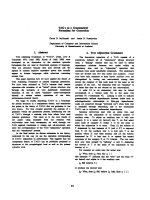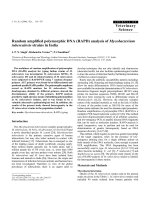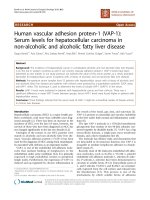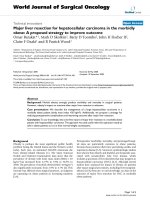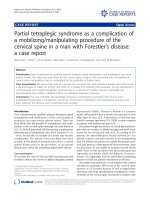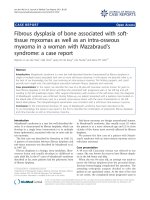Circulating microRNA’s as a diagnostic tool for hepatocellular carcinoma in a hyper endemic HIV setting, KwaZulu-Natal, South Africa: A case control study protocol focusing on viral
Bạn đang xem bản rút gọn của tài liệu. Xem và tải ngay bản đầy đủ của tài liệu tại đây (318.21 KB, 6 trang )
Sartorius et al. BMC Cancer (2017) 17:894
DOI 10.1186/s12885-017-3915-z
STUDY PROTOCOL
Open Access
Circulating microRNA’s as a diagnostic tool
for hepatocellular carcinoma in a hyper
endemic HIV setting, KwaZulu-Natal, South
Africa: a case control study protocol
focusing on viral etiology
K. Sartorius1,2,3, B. Sartorius1,3*, A. Kramvis4, E. Singh5, A. Turchinovich6,7, B. Burwinkel6, T. Madiba3 and C. A. Winkler8
Abstract
Background: A wide range of studies has investigated the diagnostic proficiency of extracellular microRNAs
(miRNAs) in hepatocellular cancer (HCC). HCC is expected to increase in Sub-Saharan Africa (SSA), due to endemic
levels of viral infection (HBV/HIV), ageing and changing lifestyles. This unique aetiological background provides an
opportunity for investigating potentially novel circulating miRNAs as biomarkers for HCC in a prospective study in
South Africa.
Methods: This study will recruit HCC patients from two South African cancer hospitals, situated in Durban and
Pietermaritzburg in the province of KwaZulu-Natal. These cases will include both HBV mono-infected and HBV/HIV
co-infected HCC cases. The control group will consist of two (2) age and sex-matched healthy population controls
per HCC case randomly selected from a Durban based laboratory. The controls will exclude patients if they have
any evidence of chronic liver disease. A standardised reporting approach will be adopted to detect, quantify and
normalize the level of circulating miRNAs in the blood sera of HCC cases and their controls. Reverse transcription
quantitative polymerase chain reaction (RT-qPCR) will be employed to quantity extracellular miRNAs. Differences in
concentration of relevant miRNA by case/control status will be assessed using the Wilcoxon rank-sum (Mann-Whitney
U) test. Adjustment for multiple testing (Bonferroni correction), receiver operating curves (ROC) and optimal breakpoint
analyses will be employed to identify potential thresholds for the differentiation of miRNA levels of HCC cases and their
controls.
Discussion: Although there is a growing base of literature regarding the role of circulating miRNAs as biomarkers, this
promising field remains a ‘work in progress’. The aetiology of HBV infection in HCC is well understood, as well as it’s
role in miRNA deregulation, however, the mediating role of HIV infection is unknown. HCC incidence in SSA, including
South Africa, is expected to increase significantly in the next decade. A combination of factors, therefore, offers a unique
opportunity to identify candidate circulating miRNAs as potential biomarkers for HBV/HIV infected HCC.
Keywords: Hepatocellular carcinoma, miRNA, Biomarker, Diagnosis, Staging, HBV, HIV
* Correspondence:
K. Sartorius and B. Sartorius are joint first authors.
1
Department of Public Health Medicine, School of Nursing and Public Health,
University of KwaZulu-Natal, Durban 4041, South Africa
3
UKZN Gastrointestinal Cancer Research Centre (GICRC), Durban, South Africa
Full list of author information is available at the end of the article
© The Author(s). 2017 Open Access This article is distributed under the terms of the Creative Commons Attribution 4.0
International License ( which permits unrestricted use, distribution, and
reproduction in any medium, provided you give appropriate credit to the original author(s) and the source, provide a link to
the Creative Commons license, and indicate if changes were made. The Creative Commons Public Domain Dedication waiver
( applies to the data made available in this article, unless otherwise stated.
Sartorius et al. BMC Cancer (2017) 17:894
Background
MicroRNAs (miRNAs) are (mostly) endogenously developed fragments of single stranded non-coding RNA
(19-25 nucleotides) that regulate more than 50% of all
cell specific protein translation. The deregulation of
miRNAs is linked to cancer because they play a role in
modulating target genes responsible for cell proliferation, apoptosis, DNA repair, invasion and metastasis [1].
The sensitivity of miRNA expression (transcription)
alteration in cancer incidence is underlined by the location of their parent genes, often found in fragile chromosomal regions that exhibit DNA amplification, deletions
and translocations which deregulate miRNA expression
[2]. Circulating miRNAs have been proposed as promising biomarkers for cancer pathologies because of their
abundance in sera, as well as their stability under
extreme conditions [3, 4]. Serum miRNAs are resistant
to ribonuclease digestion because they are protected in
protein complexes or in membranous micro-vesicles that
transport them in the circulatory system [1, 5]. The
stability of cell free, circulating miRNAs is underlined by
the fact that successful quantification has been observed
in samples stored up to 10 years at −80 degrees C [1, 6].
Despite considerable investigation of extracellular miRNAs, the use of miRNAs as biomarkers of cancer is still
regarded as a ‘work in progress’ and mostly restricted to
research programs [5, 7]. Continuing technological developments, however, like 2nd generation sequencing, as
well as a better understanding of the pathobiological role
of miRNAs, underline their future promise as clinical
biomarkers [7, 8].
A wide range of studies has investigated the diagnostic
proficiency of circulating miRNAs in liver diseases, including hepatocellular carcinoma (HCC), chronic hepatitis (CH), non-alcoholic fatty liver disease (NAFLD),
liver toxicity, cirrhosis and non-alcoholic steatohepatitis
[9–12]. The strong causal association between HCC and
CH continues to influence HCC incidence [3, 13] while
emerging studies explain the biological role of viral miRNAs [14]. Sub-Saharan Africa, and South Africa in particular, is an endemic region for both HBV and HIV
infection, as well as rapid urbanization and lifestyle
changes [15]. The aim of this study is to investigate
circulating miRNAs as biomarkers for HCC in South
Africa against a background of both HIV/HBV mono
and co-infection.
Empirical evidence of circulating miRNAs in HCC
In hepatocellular carcinoma (HCC), a range of miRNAs
is deregulated in response to cancer cells that promote
aberrant expressions in their target genes [16]. HCC deregulates the expression of circulating miRNAs (upwards
or downwards) to inversely influence the expression of
target mRNAs/ specific genes involved in cell cycle
Page 2 of 6
regulation, apoptosis, DNA repair, invasion and metastasis [2]. In HCC development, the miRNA mediated expression of mRNA can have either oncogenic effects or
promote a loss of tumor suppressor function [2, 14, 16].
Emerging evidence indicates multiple miRNAs are
deregulated in HCC. A recent reviewed collated a wide
range of studies to collectively indicate 55 miRNAs that
are down-regulated and 41 miRNAs that are upregulated in HCC [16]. The presence and proficiency of
circulating miRNA as biomarkers for HCC, have been
tested both individually, as well as in selected groups.
Examples of deregulated circulating miRNAs, identified
in numerous studies, include miR-10a, miR-21,
miR-23a/b, miR-25, miR-26a/b, miR-122, miR-125b,
miR-192, miR-222, miR-223, miR-342-3p, miR-375,
miR-423, miR-801, miR-885-5p, and miR-Let-7f [3]. It
has been suggested that miR-122a is the most abundant
miRNA in hepatocytes [9], that it is a reliable marker of
viral infection [17] and it is down-regulated in ~70% of
HCC [18]. MiR-500 is also abundantly expressed in liver
cancer cell lines and deregulation of miRNA occurs in
~45% of HCC cases [19].
HCC, viral infection and circulating miRNAs
Viruses encode their own sets of miRNA which are used
to control the expression of their host’s genes [20]. The
ability of a virus to package its own miRNAs into exosomes and transport them to non-infected cells was first
demonstrated by the EBV virus [21]. Both viral transcripts and proteins can affect host miRNA expression,
which can modulate viral and/or host protein expression
[22]. MiRNAs can bind to viral genomes or transcripts
and regulate viral infection and, conversely, viral infection (e.g. HIV/HCV) can modulate host-cell microRNA
machinery [23]. The role of miRNAs in viral infection is
being demonstrated in an increasing number of studies.
MiR-122, for instance, down-regulates HBV replication
by binding to the viral target sequence [24] and, conversely, binds to the HCV genome to increase viral
translation and replication [25–27]. MiR-199a and miR210 bind to different sites on mRNA coding of HBsAg,
reducing HBsAg expression in HepG2 2.2.15 cells [28].
MiR-15b has also been shown to modulate HBV replication by targeting the hepatocyte nuclear factor 1α
(HNF1α) [29], while miR-130a expression is increased in
HCV infection.
Two review papers, summarizing a wide range of studies [2, 3], identified a marker group of seven circulating
miRNAs, including miR-122, miR-192, miR-223, miR-21,
miR-26a, miR-27a, miR-801 that were able to distinguish
between HCC, HBV, cirrhosis and healthy controls, as
well as identify HCC tumor stages. Others have shown
that serum levels of miR-10a and miR-125b were lower
in HBV infected HCC patients than in chronic hepatitis
Sartorius et al. BMC Cancer (2017) 17:894
Page 3 of 6
B (CHB) patients and that a triplet of circulating miRNAs [namely miR-375, miR-25, miR-Let-7f] were able to
diagnose HCC with ~98% accuracy [3]. Circulating
miR-21 was also higher in HCC than chronic hepatitis
patients and healthy controls; furthermore, its levels correlated with miR-21 expressed in HCC tumor tissue and
it had better diagnostic sensitivity than alpha fetoprotein
(AFP) [2, 3]. In another study, it was found that serum
miR-21, −122, and −223 were higher in HCC and CH
versus controls, whereas miR-122 and miR-21 were
higher for CH than HCC but not miR-223 [30].
polymorphisms in their parent genes that cause small
changes in the miRNA nucleotides, thus inducing a
change in their ability to bind to mRNA targets [16].
Biological relevance of deregulated miRNAs in HCC
Study population, data/sera and sample size
Various studies are increasingly beginning to explain the
biology of specific circulating miRNAs and their potential role in HCC, with respect to cell proliferation, angiogenesis and metastasis (see Additional file 1: Table S1).
Cell proliferation in HCC is promoted by the downregulation of miR-26a, which acts as a partner with miR-195
to overcome the G1/S cell cycle blockade through the
repression of E2F expression. Cell proliferation in HCC
is also influenced by upregulated miRNAs (e.g. miR-21,
miR-216a) that promote tyrosine kinase by downregulating the PTEN tumour suppressor protein [14]. MiR-122,
for example, can inhibit angiogenesis and intrahepatic
metastasis by suppressing the expression of the tumour
necrosis factor-α- converting enzyme (TACE) [14]. The
metastasis of HCC is also influenced by miR-10a which
regulates ephrin-type-A-receptor-4 mediated mesenchymal transition [14, 16].
Data for the study are prospective and will be recruited
from all HCC patients reporting to two South African
hospitals, namely, Inkosi Albert Luthuli Central Hospital
(IALCH) in Durban, KwaZulu-Natal and Greys hospital
in Pietermaritzburg, KwaZulu-Natal. Prospective HCC
cases will be collected from January 2017 until 2020.
Each patient will complete a questionnaire that provides
both demographic and lifestyle data. Each patient will be
tested for HIV/HBV infection, as well as routine markers
assessed for each HCC patient, including AFP and ALT/
AST. A total of 200 HCC cases is estimated in the collection period and 400 healthy controls which are age
and sex matched.
Controversial issues in circulating miRNA research
Recent research indicates that miRNAs are found in all
cellular components, where they regulate transcription,
translation, alternative splicing and DNA repair [31]. A
number of unsolved issues continues to delay the use of
circulating miRNAs as viable cancer/ disease biomarkers. The mechanism of their generation and possible pathways is still being investigated [31] and their
biological role as messenger miRNAs in signaling,
remains unclear [32, 33]. A question also remains as to
whether only certain types of extracellular vesicles (e.g.
exosomes) transport messenger MiRNAs and others
merely transport small RNA as debris [7, 34]. In
addition, the elevation of extracellular miRNAs in the
blood sera of cancer patients has been attributed to general conditions like inflammation, rather than as a result
of an early stage tumor [7] Another issue is that recent
reviews suggest that methodological problems in many
earlier studies re non standardization of sample collection, sample quality control, RNA isolation, RT-qPCR
and data normalization, have rendered their findings
questionable [7, 17, 35]. Finally, the ability of miRNAs to
silence their target mRNAs, is also influenced by
Methods
Non-standard data collection and analysis have precluded the publication of many miRNA studies in high
impact journals. This study will adopt the suggested
checklist proposed by Kirschner et al., that covers sample collection, sample quality control, RNA isolation,
RT-qPCR and data normalization [35].
Blood collection for miRNA assessment
Blood will be collected from consenting patients that are
diagnosed with HCC in the oncology departments of the
IALCH and Greys hospital. An 18-20 gauge syringe needle will be used to obtain the blood sample, which will
be deposited in miRNeasy collection tubes (1.5 ml to
2 ml). Within 60 min of blood collection samples being
taken, they will be centrifuged at 2500 g for 20 min at
room temperature. Plasma supernatant will be removed
and samples frozen as 500 ul aliquots and stored at
−80 deg. C in pre-determined pools that relate to HCC
stage 1-1 V.
Assessment of haemolysis
The level of haemolysis will be assessed by using a spectrophotometer and samples will be classified as being
haemolysed if the level of free haemoglobin (OD414) exceeds a cut off (0.2). This is important in HCC with
respect to miRs 15a/−16/−210 [16], which are altered by
the haemolysis of red blood cells.
RNA isolation
The study will use a Trizol + miRNeasy modified
method to isolate miRNA from serum. Critique of different approaches indicates that non-column based purification using reagents like TRIzol or QIAzol, might be
more efficient with respect to samples with a low RNA
Sartorius et al. BMC Cancer (2017) 17:894
concentration [35]. The miRNeasy kit, however, is superior in isolating small endogenous RNA that is moderately to abundantly expressed, as well as superior with
respect to isolating exogenous spike-ins (C. elegans)
[35]. The isolation of RNA will commence by defrosting
the serum sample on ice (only invert to mix and no vortex) and transferring 400ul of serum into a fresh tube
(2 ml). 1200ul of Tri-Reagent LS (Invitrogen or Sigma)
will be added and the sample vortexed, and then incubated for 5 min at room temperature (RT), before
adding 2 ul cel-mir-39 (5fmol/ul) and 10μg glycogen
(20 mg/ml, RNA grade). The sample will be vortexed
again before adding 320ul chloroform and vortexed for
5-10 s. All samples will then be vortexed (vigorously) for
45 s and incubated at RT for 10 min. Samples will then
be centrifuged at 16000 g at room temperature before
carefully transferring the supernatant (≈800ul) into a
fresh tube (2 ml). 1.5 volumes ethanol and mix will be
added by pipetting up and down several times.
Each sample in 700ul aliquots will be added to a mini
spin column (Qiagen miRNeasy Kit) and centrifuged at
16000 g for 10 s and the flow through discarded. The
column will then be washed once with 700ul RWT
Buffer, followed by a wash with 500ul RPE Buffer, and
centrifuged at 16000 g for 15 s. The column will be
washed again by 500ul RPE Buffer and further centrifuged at 16000 g for 15 s. The column will then dry spin
for 1 min at maximum speed and be transferred to a
fresh collection tube. Finally, 50ul of RNase free water
will be added to the column, incubated for 2 min and
centrifuged at 16000 for 1 min.
RNA quantification
It is presumed that the larger sample input of 400ul will
promote the detection of RNA concentration using
standard spectrophotometry [35]. The RNA concentration will be measured using a Qubit RNA HS Assay kit
in preference to the NanoDrop, because it is presumed
that the elutes will contain contaminating proteins and
polysaccharides. The Qubit kit is also specific to ssRNA.
Reverse transcription real time quantitative PCR
This process commences with the reverse transcription
(RT) of total mature miRNA (10 ng) from the pooled
serum in order to synthesize cDNA using a TaqMan®
microRNA Reverse Transcription Kit (catalogue number
4366596; Applied Biosystems) and Megaplex RT miRNA
specific primers (catalogue number 4399966 from
Applied Biosystems). The manufacturer’s protocol will
be adhered to with respect to the reverse transcription
of up to approximately 380 miRNAs thus ensuring the
appropriate miRNA cDNA library is developed. RT will
be performed using a thermo-cycler (Mastercycler
Epgradient thermocycler; Eppendorf). The following
Page 4 of 6
specific cycling conditions will be used; 40 cycles of 16 °C
for 2 min, followed by 42 °C for 1 min and then 50 °C for
1 s. In order to de-activate the transcriptase, a final cycle
at 80 °C for 5 min is completed.
In order to ensure sufficient miRNA cDNA material is
available for RT- PCR, cDNA libraries generated from
the previous step, will be pre-amplified under supplier
directions using a primer (Megaplex PreAmp primer,
catalogue number 4399233; Applied Biosystems) and a
PreAmp Master Mix (catalogue number 4384266;
Applied Biosystems). The PreAmp primer pool selected
will be based on a library of (forward) primers that have
been identified for human miRNAs that mediate hepatocellular carcinoma and related cirrhotic conditions
including viral infection (HBV). A universal reverse primer will be employed. The pre-amplification cycling
conditions will be run under prescribed temperature and
time cycles. These include a cycle at 95 °C for 10 min, a
cycle of 55 °C for 2 min and a cycle of 72 °C for 2 min.
This will then be followed by 12 cycles of 95 °C for 30 s
and 60 °C for 4 min. Finally, the samples will then be
held at 99.9 °C for 10 min.
The expression levels of miRNA are then determined
by TaqMan Low Density Arrays (TLDA). The TLDA
step follows the pre-amplification of the cDNA libraries
[36]. TLDA commences with the dilution of product of
the previous step in RNase-free water that is combined
with a gene expression master mix (TaqMan). The diluted product is transferred onto a 384-well TaqMan
Low Density (TLDA) microarray plate (TaqMan Human
MicroRNA Array A, catalogue number 4398965;
Applied Biosystems). The microarray plate incorporates
a real-time TaqMan™ Array Microfluidic Card that has
been customized to include up to 384 microarray ‘hits’
with primers and probes situated in each well for up to
384 miRNAs.
The supplier instruction pack will be followed for RTqPCR using a sequence detection system (ABI PRISM
7900HT-Applied Biosystems) under a specific set of cycling conditions. These conditions in sequence are 50 °C
for 2 min and 94.5 °C for 10 min. The final sequences
are 40 cycles of 95 °C for 30 s and 59.7 °C for 1 min.
The cycle threshold, namely, the fractional cycle number
at which the fluorescence passes the fixed threshold of
0.2, will be generated by software (SDS 2.3 -Applied
Biosystems). An endogenous control, Mamm U6 is
embedded in the microarray (TaqMan Human
MicroRNA Arrays).
Normalization of RT-qPCR data (Cq values)
The normalization of miRNA levels will be assessed
using the average recovery of the spike-ins and this will
be compared to the standard deviation of ubiquitous
hepatocyte miRNAs like miR-122. The relative
Sartorius et al. BMC Cancer (2017) 17:894
expression levels of miRNAs will be calculated using the
comparative ΔΔCt method [37, 38]. The fold changes in
miRNAs will be calculated by the eq. 2t−ΔΔC. Cluster 3.0
software will be used to perform unsupervised hierarchical clustering, using Pearson’s correlation metrics and
average linkage methods. Java Treeview 1.1.3 will be
used to visualize the clustering results.
Statistical analysis
All statistical calculations were performed using Stata
13.0 and/or R. The Wilcoxon rank-sum (Mann–Whitney
U) test or Kruskal–Wallis test will be used to assess differences in serum concentration levels of miRNA levels
by group. Receiver operating characteristic (ROC) curves
and will be constructed and the area under the ROC
curve (AUC) calculated, along with various performance
statistics (sensitivity, specificity, PPV, NPV) based on the
estimated optimal breakpoint for a given miRNA that
best differentiates HCC cases from controls. Parametric
Linear regression analysis may be used to examine correlations between the levels of the miRNAs and a range
of HCC related variables and other liver function parameters. Non-parametric equivalents will also be employed
if the assumption of the parametric linear regression approach is not upheld. Interaction terms for co-infection
of HIV/HBV will be included to assess differences in
miRNA profile and concentration between individuals
with no infection versus discrete (singular infection)
versus co-infection. A correction for multiple testing
(Bonferroni correction) will be employed. An adjusted
P value of <0.05 will be considered statistically
significant.
Discussion
Although there is a growing base of literature regarding
circulating miRNA as potential biomarkers for cancer, this
field can still be classified as ‘a work in progress’, largely
because of the non- standardised protocols used in many
earlier studies, as well as unproved hypotheses relating to
the biology and role of circulating miRNAs [39, 40]. This
could be especially relevant in developing settings with a
high burden of oncogenic viruses (HBV/ HIV) that mediate miRNA deregulation in carcinogenesis. Given the
inherent regulatory function of miRNAs, it is highly likely
that many miRNAs (both host and viral), expressed in
relevant tissue, influence both the biological behaviour
and clinical phenotype of the tumour. The development
of powerful tools for miRNA characterization and quantitation, such as qRT-PCR and Deep Sequencing, suggests
that the discovery pipeline for miRNA biomarkers could
potentially be more efficient than “traditional” proteomic
biomarker pipelines [39]. The latter is limited by delays or
bottlenecks at the antibody generation phase as well as
Page 5 of 6
“quantitative assay development for validation of biomarker candidates” [39].
The results from this proposed study will help identify
circulating miRNAs as HCC cancer biomarkers in a setting with high HIV/HBV co-infection. As the functional
roles of miRNAs in HCC development are further elucidated and better understood, we foresee that HCC
specific blood-based miRNA biomarkers will be useful in
both diagnosing HCC at an earlier stage, as well as
assisting with predicting the clinical course and/or therapeutic response to currently available therapies.
Additional file
Additional file 1: Table S1. MiRNA deregulation, targets and effect in
HCC. (DOCX 12 kb)
Abbreviations
BREC: Biomedical Research Ethics Committee; CH: Chronic hepatitis;
HBV: Hepatitis B virus; HCC: Hepatocellular cancer; HCV: Hepatitis C virus;
HIV: Human Immunodeficiency virus; IALCH: Inkosi Albert Luthuli Central
Hospital; KZN: Kwazulu-Natal; NAFLD: Non-alcoholic fatty liver disease;
NASH: Non-alcoholic steatohepatitis; NPV: Negative predictive value;
PLC: Primary liver cancer; PPV: Positive predictive value; ROC: Receiver
operating characteristic; RT-PCR: Reverse transcription polymerase chain
reaction; SSA: Sub-Saharan Africa; UTR: Untranslated region
Acknowledgements
Not applicable.
Funding
This study will be largely funded through the South African Medical Research
Council [MRC] (Grant reference: MRC-RFA-CCRC-01-2014). This project will also be
funded with federal funds from the National Cancer Institute, National Institute of
Health, under contract HHSN26120080001E. The content of this publication does
not necessarily reflect the views or policies of the Department of Health and
Human Services, nor does mention of trade names, commercial products, or
organizations imply endorsement by the U.S. Government. This research will be
supported in part by the Intramural Research Program of the NIH, National Cancer
Institute, Center for Cancer Research.
Availability of data and materials
Not applicable.
Authors’ contributions
KS and BS formulated the study concept and design. AK reviewed and corrected
manuscript specifically with respect to viral component. AT and BB reviewed and
corrected manuscript specifically with respect to all miRNA biology and proposed
method. ES, TM, CW reviewed and corrected manuscript especially with respect
to HCC component of proposal. All authors contributed to the study protocol and
were involved with reviewing all the iterations. All authors reviewed and
approved final manuscript.
Ethics approval and consent to participate
Ethics approval for this study has been received from the Biomedical Research
Ethics Committee (BREC) at University of KwaZulu-Natal (BREC Reference Number:
BE059/15). All study participants will sign an informed consent form before
participating in the study. Patient confidentiality will be ensured.
Consent for publication
Not applicable.
Competing interests
The authors declare that they have no competing interests.
Sartorius et al. BMC Cancer (2017) 17:894
Publisher’s Note
Springer Nature remains neutral with regard to jurisdictional claims in
published maps and institutional affiliations.
Author details
1
Department of Public Health Medicine, School of Nursing and Public Health,
University of KwaZulu-Natal, Durban 4041, South Africa. 2Faculty of
Commerce, Law and Management, University of the Witwatersrand,
Johannesburg, South Africa. 3UKZN Gastrointestinal Cancer Research Centre
(GICRC), Durban, South Africa. 4Hepatitis Virus Diversity Research Unit,
Department of Internal Medicine, School of Clinical Medicine, Faculty of
Health Sciences, University of the Witwatersrand, Parktown, Johannesburg,
South Africa. 5South African National Cancer Registry, National Health
Laboratory Service, Johannesburg, South Africa. 6Molecular Epidemiology
Group, German Cancer Research Centre, Heidelberg, Germany. 7SciBerg
e.Kfm, Mannheim, Germany. 8Basic Research Laboratory, Centre for Cancer
Research, National Cancer Institute, Leidos Biomedical Research, Inc. Frederick
Nat. Lab. for Cancer Research, Frederick, MD, USA.
Received: 6 December 2016 Accepted: 14 December 2017
References
1. Kosaka N, Iguchi H, Ochiya T. Circulating microRNA in body fluid: a new
potential biomarker for cancer diagnosis and prognosis. Cancer Sci. 2010;
101(10):2087–92.
2. Schwarzenbach H, Nishida N, Calin GA, Pantel K. Clinical relevance of
circulating cell-free microRNAs in cancer. Nat Rev Clin Oncol. 2014;11(3):
145–56.
3. Enache LS, Enache EL, Ramière C, Diaz O, Bancu L, Sin A, André P.
Circulating RNA molecules as biomarkers in liver disease. Int J Mol Sci. 2014;
15(10):17644–66.
4. Gui J, Tian Y, Wen X, Zhang W, Zhang P, Gao J, Run W, Tian L, Jia X, Gao Y.
Serum microRNA characterization identifies miR-885-5p as a potential
marker for detecting liver pathologies. Clin Sci. 2011;120(5):183–93.
5. Mo M-H, Chen L, Fu Y, Wang W, Fu SW. Cell-free circulating miRNA
biomarkers in cancer. J Cancer. 2012;3:432–48.
6. Pritchard CC, Kroh E, Wood B, Arroyo JD, Dougherty KJ, Miyaji MM, Tait JF,
Tewari M. Blood cell origin of circulating microRNAs: a cautionary note for
cancer biomarker studies. Cancer Prev Res. 2012;5(3):492–7.
7. Witwer KW. Circulating microRNA biomarker studies: pitfalls and potential
solutions. Clin Chem. 2015;61(1):56–63.
8. Etheridge A, Gomes CP, Pereira RW, Galas D, Wang K. The complexity, function,
and applications of RNA in circulation. The origin, function and diagnostic
potential of extracellular microRNA in human body fluids; 2014. p. 19.
9. Szabo G, Bala S. MicroRNAs in liver disease. Nat Rev Gastroenterol Hepatol.
2013;10(9):542–52.
10. Zhang Y, Jia Y, Zheng R, Guo Y, Wang Y, Guo H, Fei M, Sun S. Plasma
microRNA-122 as a biomarker for viral-, alcohol-, and chemical-related
hepatic diseases. Clin Chem. 2010;56(12):1830–8.
11. Bala S, Petrasek J, Mundkur S, Catalano D, Levin I, Ward J, Alao H, Kodys K,
Szabo G. Circulating microRNAs in exosomes indicate hepatocyte injury and
inflammation in alcoholic, drug-induced, and inflammatory liver diseases.
Hepatology. 2012;56(5):1946–57.
12. Coulouarn C, Factor VM, Andersen JB, Durkin ME, Thorgeirsson SS. Loss of
miR-122 expression in liver cancer correlates with suppression of the
hepatic phenotype and gain of metastatic properties. Oncogene. 2009;
28(40):3526–36.
13. Zhou J, Yu L, Gao X, Hu J, Wang J, Dai Z, Wang J-F, Zhang Z, Lu S, Huang X.
Plasma microRNA panel to diagnose hepatitis B virus–related hepatocellular
carcinoma. J Clin Oncol. 2011;29(36):4781–8.
14. Sun J, Lu H, Wang X, Jin H. MicroRNAs in hepatocellular carcinoma:
regulation, function, and clinical implications. Sci World J. 2013;924206.
/>15. Mphahlele MJ, Lukhwareni A, Burnett RJ, Moropeng LM, Ngobeni JM. High
risk of occult hepatitis B virus infection in HIV-positive patients from South
Africa. J Clin Virol. 2006;35:14–20.
16. Morishita A, Masaki T. miRNA in hepatocellular carcinoma. Hepatol Res.
2015;45(2):128–41.
Page 6 of 6
17. Turchinovich A, Tonevitsky AG, Cho WC, Burwinkel B. Check and mate to
exosomal extracellular miRNA: new lesson from a new approach. Front Mol
Biosci. 2015;2:11.
18. Gramantieri L, Ferracin M, Fornari F, Veronese A, Sabbioni S, Liu C-G, Calin
GA, Giovannini C, Ferrazzi E, Grazi GL. Cyclin G1 is a target of miR-122a, a
microRNA frequently down-regulated in human hepatocellular carcinoma.
Cancer Res. 2007;67(13):6092–9.
19. Yamamoto Y, Kosaka N, Tanaka M, Koizumi F, Kanai Y, Mizutani T, Murakami
Y, Kuroda M, Miyajima A, Kato T. MicroRNA-500 as a potential diagnostic
marker for hepatocellular carcinoma. Biomarkers. 2009;14(7):529–38.
20. Laganà A, Russo F, Veneziano D, Di Bella S, Pulvirenti A, Giugno R, Croce
CM, Ferro A. Extracellular circulating viral microRNAs: current knowledge
and perspectives. Front Genet. 2013;4:120.
21. Laguna JC, Alegret M, Roglans N. Simple sugar intake and Hepatocellular
carcinoma: epidemiological and mechanistic insight. Nutrients. 2014;6(12):
5933–54.
22. Bandiera S, Pfeffer S, Baumert TF, Zeisel MB. miR-122–a key factor and
therapeutic target in liver disease. J Hepatol. 2015;62(2):448–57.
23. Piedade D, Azevedo-Pereira JM: MicroRNAs, HIV and HCV: a complex
relation towards pathology. Rev Med Virol. 2016;26(3):197–215.
24. Chen Y, Shen A, Rider PJ, Yu Y, Wu K, Mu Y, Hao Q, Liu Y, Gong H, Zhu Y,
et al. A liver-specific microRNA binds to a highly conserved RNA sequence
of hepatitis B virus and negatively regulates viral gene expression and
replication. FASEB J. 2011;25(12):4511–21.
25. Jopling CL, Yi M, Lancaster AM, Lemon SM, Sarnow P. Modulation of
hepatitis C virus RNA abundance by a liver-specific MicroRNA. Science. 2005;
309(5740):1577–81.
26. Jopling CL, Schutz S, Sarnow P. Position-dependent function for a tandem
microRNA miR-122-binding site located in the hepatitis C virus RNA
genome. Cell Host Microbe. 2008;4(1):77–85.
27. Li Y, Masaki T, Yamane D, McGivern DR, Lemon SM. Competing and
noncompeting activities of miR-122 and the 5′ exonuclease Xrn1 in
regulation of hepatitis C virus replication. Proc Natl Acad Sci U S A. 2013;
110(5):1881–6.
28. Zhang GL, Li YX, Zheng SQ, Liu M, Li X, Tang H. Suppression of hepatitis B
virus replication by microRNA-199a-3p and microRNA-210. Antivir Res. 2010;
88(2):169–75.
29. Dai X, Zhang W, Zhang H, Sun S, Yu H, Guo Y, Kou Z, Zhao G, Du L, Jiang S,
et al. Modulation of HBV replication by microRNA-15b through targeting
hepatocyte nuclear factor 1alpha. Nucleic Acids Res. 2014;42(10):6578–90.
30. Xu J, Wu C, Che X, Wang L, Yu D, Zhang T, Huang L, Li H, Tan W, Wang C.
Circulating MicroRNAs, miR-21, miR-122, and miR-223, in patients with
hepatocellular carcinoma or chronic hepatitis. Mol Carcinog. 2011;50(2):136–42.
31. Makarova JA, Shkurnikov MU, Wicklein D, Lange T, Samatov TR, Turchinovich
AA, Tonevitsky AG: Intracellular and extracellular microRNA: an update on
localization and biological role. Prog Histochem Cytochem. 2016;51(3-4):33–
49. doi:10.1016/j.proghi.2016.06.001. Epub 2016 Jun 25.
32. Turchinovich A, Weiz L, Burwinkel B. Extracellular miRNAs: the mystery of
their origin and function. Trends Biochem Sci. 2012;37(11):460–5.
33. Turchinovich A, Samatov T, Tonevitsky A, Burwinkel B. Circulating miRNAs:
cell–cell communication function? The origin, function and diagnostic
potential of extracellular microRNA in human body fluids; 2014. p. 27.
34. Turchinovich A, Tonevitsky AG, Burwinkel B. Extracellular miRNA: a collision
of two paradigms. Trends Biochem Sci. 2016;41(10):883–92.
35. Kirschner MB, van Zandwijk N, Reid G. Cell-free microRNAs: potential
biomarkers in need of standardized reporting. Front Genet. 2013;4:56.
36. Turchinovich A, Burwinkel B. Distinct AGO1 and AGO2 associated miRNA
profiles in human cells and blood plasma. RNA Biol. 2012;9(8):1066–75.
37. Schmittgen TD, Livak KJ. Analyzing real-time PCR data by the comparative
CT method. Nat Protoc. 2008;3(6):1101–8.
38. Livak KJ, Schmittgen TD. Analysis of relative gene expression data using
real-time quantitative PCR and the 2− ΔΔCT method. Methods. 2001;25(4):
402–8.
39. Mitchell PS, Parkin RK, Kroh EM, Fritz BR, Wyman SK, Pogosova-Agadjanyan
EL, Peterson A, Noteboom J, O'Briant KC, Allen A. Circulating microRNAs as
stable blood-based markers for cancer detection. Proc Natl Acad Sci. 2008;
105(30):10513–8.
40. Tsang JC, Dennis Lo Y. Circulating nucleic acids in plasma/serum. Pathology.
2007;39(2):197–207.
